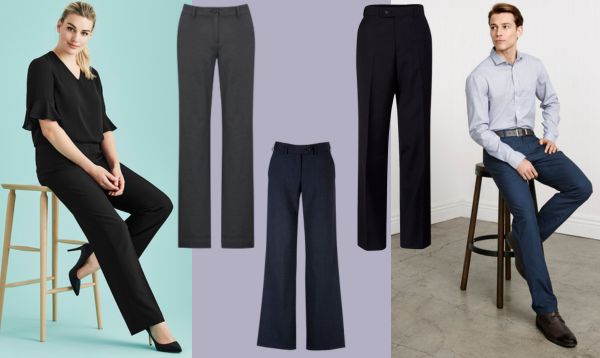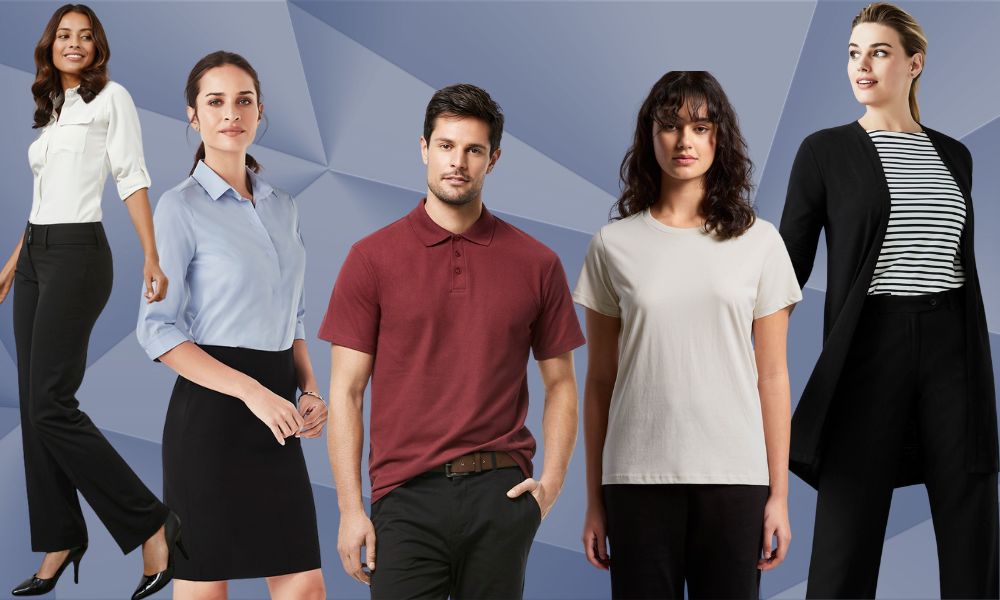Ever thought about what makes a uniform really work? The key is picking the right basics. It’s about selecting the appropriate things that ties everything together, not just always grabbing a shirt and jeans. Whether your team is in retail, hospitality, or any other field, having a few essential uniform pieces can make a big difference.
Wearing the proper uniform offers your team confidence and a sense of community in addition to making them look polished. An employee’s performance and customer interactions will automatically improve when they feel good about what they are wearing. You may assist your staff feel at ease and pleased to wear your brand by investing in a few essential pieces that can be worn in a variety of seasons and settings. Let’s explore the seven uniform essentials that every business should think about and take a closer look at what makes these essentials so important.
1. Classic Work Pants
The classic work pants are the most important item for any uniform. For any business, a pair of well-made, basic trousers in a neutral colour like grey, black, or navy is a wise choice. These colours ensure that your team looks uniform without breaking the bank because they are adaptable, low maintenance, and readily available from a variety of merchants. Additionally, affordable yet high-quality.

The key to getting the classic work pants right is in the details. Opt for trousers that are neat and free from any tears, fading, or excessive wear. It’s important to go for a style that maintains a professional appearance—no low-rise cuts here. Instead, choose mid-rise or high-rise options that provide comfort and coverage while keeping the look polished. The fit should be neither too tight nor too loose, ensuring your staff can move comfortably throughout their day. By standardizing the work pant, you’re creating a solid foundation for the rest of your uniform, making it easier to mix and match with other pieces.
2. A Classic Shirt
If your budget doesn’t allow for a full head-to-toe uniform, investing in quality shirts is the next best thing. A well-designed shirt can do wonders for your company’s image, even if the rest of the outfit isn’t strictly uniform. The key here is to offer a few different options that reflect your brand’s identity. Think about developing two or three shirt styles in your company’s colours—options like plain, striped, or checked patterns work well. When selecting shirts, it’s important to consider different fits and sleeve lengths. Offer relaxed and tailored cuts to cater to different body shapes and preferences. Some team members might prefer short sleeves for comfort, while others might lean towards long sleeves for a more formal look. By providing these choices, you make sure everyone feels comfortable and confident in their uniform.
It’s also worth picking a modern and stylish design that your team will actually enjoy wearing. A shirt that fits well and looks good will be worn more often, becoming a staple in your uniform wardrobe. This approach not only maintains a professional look but also boosts team morale by making your staff feel good about what they’re wearing. Branding these shirts with your company logo ensures a uniform look, even if employees have slightly different styles. Pick a modern design that staff will be proud to wear, making the shirt a staple in your uniform wardrobe.
3. Clean, Simple Shoes 
Footwear is an important element of any uniform, and setting clear guidelines around what is and isn’t acceptable is essential. If sandals are permitted, specify the style—should they be closed-toe? and if so, what colour is appropriate? For closed shoes, decide whether sneakers are acceptable and, if they are, what colour they should be.
The key is to match the footwear with the overall look of the uniform. For example, if your team is wearing chinos or jeans on a casual day, white trainers can be a great choice. They keep the look relaxed but still tidy. For more formal or corporate days, black or navy shoes might be a better fit, as they align with a more professional appearance. By setting these boundaries, you ensure that footwear complements the uniform rather than detracting from it.
 4. Simple Polo Shirt
4. Simple Polo Shirt
If you’re dressing casually for events, workdays, or jobs in hospitality, a basic polo shirt is a great option. Its effortless design effortlessly combines comfort and style to enhance the usefulness of any outfit. Dress them up or down, polo shirts are versatile and practical accessories. For a night out or simply with jeans, they look fantastic with jeans and chinos.
Because they match with almost anything, neutral colours like black, white, or navy make excellent choices for your team’s polo shirts. If you want to keep your branding consistent, choose colours that best represent your business. To ensure that your staff members are comfortable in a range of weather situations and seasons, it’s also a good idea to offer options for both long and short sleeves.
5. Branded T-Shirt
A branded t-shirt is a perfect uniform essential for more relaxed environments or for specific occasions like casual Fridays, team-building events, or staff parties. It’s also an excellent option for roles that require more physical activity, such as in warehouses or during company outings. The t-shirt should be comfortable yet durable, with a design that features your company’s branding in a prominent but tasteful way.
For example, you might use t-shirts with your company’s logo for an office team during casual Fridays or provide them for staff members who are helping out at a community event. If your company is hosting an outdoor team-building exercise, branded t-shirts can help your team feel united while staying comfortable and active. This not only promotes your brand but also keeps the team looking unified and professional, even on more casual days.
6. Warm Layer
As the seasons shift and temperatures drop, it’s important to provide your team with a warm layer that fits seamlessly with the rest of the uniform. Without a designated warm layer, employees might end up wearing their own personal jackets or sweaters, leading to an inconsistent look. To address this, consider offering a branded warm layer such as a knit sweater, fleece jacket, or insulated coat. For example, a simple zip-up fleece jacket in a neutral colour like navy, black, or grey can complement various uniform pieces while keeping staff warm. Alternatively, a cozy knit sweater with your company’s logo subtly embroidered on it can add a touch of professionalism and brand unity.
By providing these warm layers, you ensure that your team maintains a cohesive appearance throughout the colder months. These items not only help keep your employees comfortable but also reinforce your brand’s image, showing that even in cooler weather, consistency and professionalism are a priority.
 7. Practical Accessories
7. Practical Accessories
Lastly, it’s important to think about the little touches that can enhance and complete your uniform—practical accessories. These small details can make a big difference in achieving a polished and professional look. Consider accessories like belts, ties, scarves, and hats. For instance, a sleek leather belt in black or brown can be a standard part of the uniform. It helps keep trousers in place and adds to the overall tidy appearance. A well-chosen belt can make a simple outfit look more put-together.
Branded hats or scarves are also great additions, especially for staff who work outdoors or in cooler environments. For example, a logo-emblazoned cap or a warm scarf with your company’s colours can keep employees comfortable while reinforcing your brand. These accessories might seem minor, but they significantly contribute to a polished and cohesive uniform look. By paying attention to these details, you ensure that every aspect of your team’s appearance reflects professionalism and consistency.

